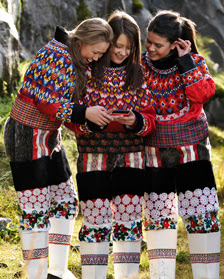Rabu, 03 Juli 2013
Fashion Embroidery
From ancient times, traditional Ukrainian embroidered ornaments вишиванки on clothing have also performed the function of magical talisman - protection for the wearer. It is a symbolic vocabulary - with a power of its own.
Ukrainian embroidery has never been something ordinary, especially because each piece carries the energy of the person who worked and embroidered.
http://ukrainiancalgary.blogspot.com/2012_12_01_archive.html
Posted by: Novelia Meida Kusuma
Swedish Folk Costumes
"uniform Swedish folk costume". The costumes were only worn by the people in the countryside, farmers, their families and servants, and it changed and developed over hundreds of years, and look very different in different parts of Sweden. Some areas have no documented folk costumes at all.
http://amostpeculiarmademoiselle.blogspot.com/2009/10/long-post-on-swedish-folk-costumes.html
Posted by: Novelia Meida Kusuma
Kuchi Dress
The material is soft, breathable, and light weight, perfect for the summer. Comes with matching pants, head scarf, and adjustable belt at the waist.
http://www.zarinas.com/dresses2.shtml
Posted by: Kasih Andaresta
Vietnamese Traditional Clothing
People in Vietnam wear cotton clothes. The Vietnamese typically wear lightweight clothing. Rural women wear loose-fitting dark-pants and blouses that are often embroideredin brilliant colors. Conical nats called non la shield their faces from the sun. In the cities, many girls and women wear the traditional au dai, a long tunic worn with loose-fitting pants. However, a growing number of urban women wear dresses and shirts. Rural and working class men typically wear simple shirts and trousers. City men generally wear Western-style clothing.
http://www.asian-recipe.com/vietnam/vn-information/vietnamese-traditional-clothing.html
Posted by: Novelia Meida kusuma
Posted by: Novelia Meida kusuma
Traditional Russian clothing
Traditional Russian clothing was designed to empathize Russian woman's inner dignity and emotional restraint. Russian costumes are not only beautiful, there are also convenient in wearing because they were created for work without restricting freedom of movement. Festive clothes and everyday clothes, married woman's and young girl's clothes differed only for details, decoration, color gamut. The variety of colors for traditional costume displays love for beauty and ethnic diversity.
http://traditionalclothingoftheworld.blogspot.com/2012/07/traditional-russian-clothing.html
Posted by: Novelia Meida Kusuma
http://traditionalclothingoftheworld.blogspot.com/2012/07/traditional-russian-clothing.html
Posted by: Novelia Meida Kusuma
Hmong Costumes
One of the more fun aspects of Hmong culture are Hmong costumes, although the name "costume" may be misleading. Hmong costumes are really a traditional dress/fashion that is most often worn on special events or during Hmong dances. Hmong culture also allows for the integration of more modern style over time, so many of these costumes have been updated and advanced as time has passed.
http://voices.yahoo.com/4-types-hmong-costumes-8885379.html?cat=16
Posted by: Novelia Meida Kusuma
Traditional Hijab series
Traditional hijab is basically the type of culturally-defined covering worn by Muslim women in their own society or cultural group. For example the Baloochi women of Iran wear a different style of traditional hijab from Bandari Arab women in southern Iran. Basically its just a showcase of these unique and beautiful designs which have developed over hundreds and perhaps thousands of years.
http://www.oldschoolhijabi.com/stores-i-recommend/
Posted by: Novelia Meida kusuma
ABOUT GREENLAND
From traditional dress to national costume
When the Europeans set foot in Greenland in the 17th and 18th centuries, they brought with them clothing fabrics and glass beads as goods to trade. These materials gradually become incorporated into the Inuits' dress, particularly for festive attire. For men the hide trousers were replaced by a thick woollen material called 'holmensklæde' (literally island cloth), and for women the anorak was sewn in silks. The glass beads were initially used in the same way as when decorating oneself with beads fashioned from bone. It gradually became prestigious to use more and more beads, and this trend is particularly visible on the women's national costume.
http://www.greenland.com/en/about-greenland/kultur-sjael/nationaldragter.aspx
Posted by: Novelia Meida Kusuma
Traditional Batik Motif Yogyakarta
Traditional Batik Motif Yogyakarta
Batik patterns are divided into different families of designs, each with hundreds of variations within them. The following gives you a brief introduction to the main design families. You'll see certain designs that belonged to the sacred, forbidden patterns reserved for the royal court. Over time, these particular patterns did enter into common use. Yet to this day, if a person does not belong to the court, they would never wear those patterns inside the keraton, or palace walls.
Ceplok Motifs
http://www.winotosastro.com/batik/batikyogya.html
Posted by: Novelia Meida Kusuma
Langganan:
Postingan (Atom)







